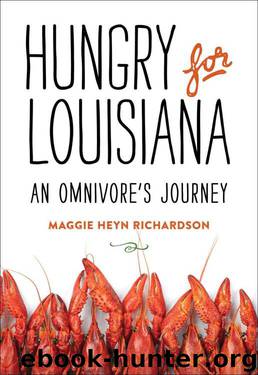Hungry for Louisiana: An Omnivore's Journey by Maggie Heyn Richardson

Author:Maggie Heyn Richardson [Richardson, Maggie Heyn]
Language: eng
Format: epub
Publisher: LSU Press
Published: 2015-03-08T22:00:00+00:00
By the end of the twentieth century, snoballs had become fairly commonplace throughout Louisiana and in other parts of the Gulf South, thanks to the availability of commercial machines from companies like SnoWizard and Southern Snow, another New Orleans–based vendor. Today, the SnoWizard business is run by Ortolano’s nephew, Ronnie Sciortino, a former chef with an eye for detail who once worked at now-closed New Orleans legacy restaurants LeRuth’s and Stephen & Martin.
In the early 1980s, Ronnie introduced a new component to Sno-Wizard’s equipment business—commercial syrups. He bought an existing syrup business and used his fine-tuned palate to significantly expand the company’s lineup of flavors. Piña colada was one of the first. “It was one of my favorite drinks, so I started thinking about what went into one, and how you could correlate that with chemical and natural extracts,” says Ronnie. “I kept notes on the percentages, and kept tasting the syrup against the real thing.”
Under Sciortino’s direction, SnoWizard now offers about 140 syrups, including classic New Orleans flavors nectar, orchid cream, and Creole cream cheese, as well as flavors for growing markets in Texas, such as cherimoya, dulce de leche, and tamarind. Ronnie spends months and even years developing a new flavor, making infinitesimal adjustments down to parts-per-million until the concentrate tastes like the item he is mimicking. In the case of cherimoya, a tropical fruit not widely available in New Orleans, he mail-ordered a case and began tasting tiny slivers as he worked in the company’s large laboratory. The fruit’s diverse combination of flavors emerged on his tongue—banana, peach, strawberry, apple, and bubblegum, among others—and Ronnie scribbled possible formulas for replicating it. He loves this part of the job, an extension of his belief in culinary precision. Even when he’s making a forgiving dish like red beans and rice at home, Ronnie uses a scale to measure his dry seasonings down to the gram.
Smartly dressed and sitting near displays of the snoball machines his uncle invented at the SnoWizard headquarters, Ronnie tells me that a lot of people get into the snoball business thinking it’s going to be easy money, but they learn fast that strong sales depend on good snoballs. And good snoballs depend on three factors.
Number one, he says, is the temperature of the ice, which has to be kept at five to ten degrees above freezing. If it’s too hard when it hits the blades, the shaved ice comes out like talcum powder. If the ice is too soft, the shavings will clump.
The second factor is the sharpness of blades. A good operator sharpens his blades religiously because when the blades dull they produce hard chunks, not soft flurries.
And the third factor is the operator himself, who holds sway over the quality of the confection simply by the way he runs the machine. When the blades are sharp and the ice is right, light pressure is best. But these conditions change every minute of the day, requiring the operator to work by feel.
At Williams Plum
Download
This site does not store any files on its server. We only index and link to content provided by other sites. Please contact the content providers to delete copyright contents if any and email us, we'll remove relevant links or contents immediately.
| Cajun & Creole | California |
| Hawaiian | Mid-Atlantic |
| Midwestern | New England |
| Northwestern | Soul Food |
| Southern | Southwestern |
| Western |
Biscuits: A Savor the South Cookbook by Belinda Ellis(3913)
Al Roker's Hassle-Free Holiday Cookbook by Al Roker(3185)
A Jewish Baker's Pastry Secrets: Recipes from a New York Baking Legend for Strudel, Stollen, Danishes, Puff Pastry, and More by George Greenstein(3121)
Ottolenghi Simple by Yotam Ottolenghi(3047)
Trullo by Tim Siadatan(3001)
The French Women Don't Get Fat Cookbook by Mireille Guiliano(2991)
Better Homes and Gardens New Cookbook by Better Homes & Gardens(2970)
Bake with Anna Olson by Anna Olson(2945)
Panini by Carlo Middione(2834)
Hot Thai Kitchen by Pailin Chongchitnant(2821)
Nigella Bites (Nigella Collection) by Nigella Lawson(2789)
Momofuku by David Chang(2772)
Modern French Pastry: Innovative Techniques, Tools and Design by Cheryl Wakerhauser(2732)
Salt, Fat, Acid, Heat: Mastering the Elements of Good Cooking by Nosrat Samin(2668)
Tapas Revolution by Omar Allibhoy(2546)
Classic by Mary Berry(2510)
Solo Food by Janneke Vreugdenhil(2499)
Best of Jane Grigson by Jane Grigson(2473)
Okonomiyaki: Japanese Comfort Food by Saito Yoshio(2395)
